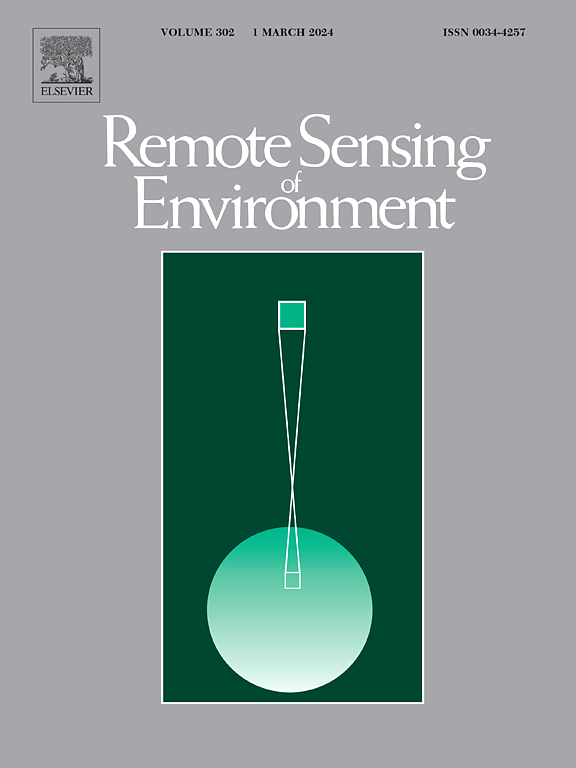Sentinel-2、Landsat-8和MODIS卫星冠层含水量:原理、算法和评估
IF 11.1
1区 地球科学
Q1 ENVIRONMENTAL SCIENCES
引用次数: 0
摘要
尽管目前在植被冠层含水量(CWC)制图方面做了很多努力,包括基于微波植被光学深度(VOD)的植被水分代用以及基于光学指数的植被水分代用,但目前还没有可操作的光学卫星CWC产品。为了填补这一空白,本研究提出了一种统一的算法,用于在十分制和粗空间分辨率下从几个广泛使用的光学卫星进行CWC制图。基于辐射传输模型模拟训练的机器学习,我们依托全球最大的开放式植物和土壤光谱综合数据库,对PROSAIL模型的冠层和植被输入变量(即叶片性状和土壤背景)的分布进行了综合参数化。我们研究了不同波段组合以及包含光学指标对使用rtm估算CWC的影响。该算法的性能首先在十米分辨率下进行了评估,基于分布在五个不同气候和生物群系类型对应的地面运动的地面测量。从Sentinel-2和Landsat-8卫星上回收的CWC表现出满意的性能,R系数为0.81,RMSE为0.046 g/cm2。然后,我们通过将MODIS数据与Landsat-8和Sentinel-2在全球分布的LANDVAL站点上的汇总值进行比较,评估了500 m分辨率下的CWC,这些站点代表了现有的生物群落类型,并结合了一系列降水、土壤湿度和植被密度条件。与基于多频率微波的VOD相比,MODIS CWC全球地图显示出合理的季节和空间格局,与传统和广泛使用的光学指数(如NDWI)相比,MODIS CWC全球地图也有所改进。本研究开发的CWC产品有望为光学卫星监测全球或区域植被水分变化提供新的见解,与微波无源VOD(即20-500 m vs 22.5 km)相比,它具有高空间分辨率的强度。这两种产品可以进一步结合起来,在未来更准确地绘制全球植被水分和生物量地图,以提高我们对碳吸收和水文应用的理解。本文章由计算机程序翻译,如有差异,请以英文原文为准。
Satellite canopy water content from Sentinel-2, Landsat-8 and MODIS: Principle, algorithm and assessment
In spite of the efforts made for canopy water content (CWC) mapping in the community, including vegetation water proxy from microwave-based vegetation optical depth (VOD) as well as optical-based indices, there is still no operational CWC product from optical satellites up to now. To fill this gap, this study proposes a unified algorithm for CWC mapping at both decametric and coarse spatial resolution from several widely used optical satellites. Based on machine learning trained on radiative transfer model simulations, we comprehensively parameterized the distribution of the canopy and vegetation input variables (i.e., leaf traits and soil background) of the PROSAIL model, by relying on the largest open integrated global plant and soil spectral databases. We investigated the impact of diverse band combinations as well as the inclusion of optical indices for CWC estimation using RTMs. The performances of this algorithm were first evaluated at decametric resolution based on ground measurements distributed over five ground campaigns corresponding to diverse climate and biome types. The retrieved CWC from Sentinel-2 and Landsat-8 exhibits satisfactory performance, with coefficient R of 0.81 and RMSE of 0.046 g/cm2. We then evaluated CWC at 500 m resolution from MODIS by comparing it with Landsat-8 and Sentinel-2 aggregated values over a globally distributed selection of LANDVAL sites, representative of the existing biome types combined with a range of precipitation, soil moisture and vegetation density conditions. The MODIS CWC global maps show reasonable seasonal and spatial patterns compared to multi-frequencies microwave-based VOD, and improvements compared to the conventionally and extensively used optical indices such as NDWI. The CWC product developed in this study is expected to provide new insights for global or regional vegetation water variations monitoring from optical satellites, with the strength of high spatial resolution compared to the microwave passive VOD (i.e., 20-500 m vs 22.5 km). These two products could be further combined for more accurate global vegetation water and biomass mapping in the future to improve our understanding of carbon uptake and hydrological applications.
求助全文
通过发布文献求助,成功后即可免费获取论文全文。
去求助
来源期刊

Remote Sensing of Environment
环境科学-成像科学与照相技术
CiteScore
25.10
自引率
8.90%
发文量
455
审稿时长
53 days
期刊介绍:
Remote Sensing of Environment (RSE) serves the Earth observation community by disseminating results on the theory, science, applications, and technology that contribute to advancing the field of remote sensing. With a thoroughly interdisciplinary approach, RSE encompasses terrestrial, oceanic, and atmospheric sensing.
The journal emphasizes biophysical and quantitative approaches to remote sensing at local to global scales, covering a diverse range of applications and techniques.
RSE serves as a vital platform for the exchange of knowledge and advancements in the dynamic field of remote sensing.
 求助内容:
求助内容: 应助结果提醒方式:
应助结果提醒方式:


